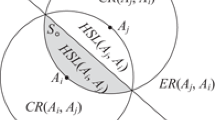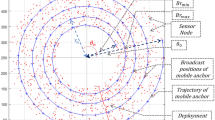Abstract
In wireless sensor networks, location information is crucial to effectively use the event information recorded by the sensors. However, localizing mobile sensor nodes in resource-constrained networks presents several challenges, including determining the optimal number of anchor nodes, handling mobility, designing a path loss model, considering network topology, and addressing scalability and the number of localized nodes. To overcome these challenges, this paper proposes a coordinate-based auto-localization algorithm (CALA) with a single anchor node for mobile sensor nodes. The proposed algorithm uses an analytical model to determine the location of the target node by considering a parallel coordinate system and retrieving the original location of the target node by moving it to two different locations. The algorithm uses received signal strength indicator (RSSI) values for distance calculation while considering Rayleigh fading in the path loss model. The proposed algorithm’s performance is evaluated using various parameter settings, including mobility, node density, fading, path loss exponent, and different random seed values. The study finds that fading and path loss significantly influence the localization process, leading to an accuracy range of 10 to 30% when measuring distances using RSSI. The proposed method shows a 30% improvement in localization accuracy when the number of nodes increases from 5 to 20, achieving an average localization accuracy of 90% in a network with 20 sensor nodes. Furthermore, the study offers an in-depth investigation of the effect of various random generating situations on localization accuracy. Overall, the proposed algorithm offers a promising solution to the challenges of localizing mobile sensor nodes in resource-constrained networks.















Similar content being viewed by others
Availability of data and materials
Not applicable.
References
Wang C, Xiao L (2008) Sensor localization in concave environments. ACM Trans Sens Netw. https://doi.org/10.1145/1325651.1325654
Paul AK, Sato T (2017) Localization in WSNs: a survey on algorithms, measurement techniques, applications and challenges. J Sens Actuator Netw 6:24. https://doi.org/10.3390/jsan6040024
Musa A, Gonzalez V, Barragan D (2019) A new strategy to optimize the sensors placement in WSNs. J Ambient Intell Humaniz Comput 10(4):1389–1399. https://doi.org/10.1007/s12652-018-0868-2
Chen S, Zhang J, Mao Y, Xu C, Gu Y (2019) Efficient distributed method for NLOS cooperative localization in WSNs. Sensors 19(5):1173. https://doi.org/10.3390/s19051173
Bhat SJ, Santhosh KV (2022) Localization of isotropic and anisotropic WSNs in 2D and 3D fields. Telecommun Syst 79:309–321. https://doi.org/10.1007/s11235-021-00862-2
Lita I et al (2006) A new approach of automobile localization system using GPS and GSM/GPRS transmission. International Spring Seminar on Electronics Technology
Stoleru R et al (2004) Walking GPS: A practical solution for localization in manually deployed WSNs. In: IEEE International Conference on Local Computer Networks
Stefano P, Pascucci F, Ulivi G (2002) An outdoor navigation system using GPS and inertial platform. In: IEEE/ASME Transactions on Mechatronics
Parkinson B et al (1996) Global positioning system: theory and application. Progress in Astronautics and Aeronautics, vol I
Chowdhury T, Elkin C, Devabhaktuni V, Rawat DB, Oluoch J (2016) Advances on localization techniques for WSNs. Comput Netw 110:284–305
Halder S, Ghosal A (2016) A survey on mobile anchor assisted localization techniques in WSNs. Wirel Netw 22:2317–2336
Kuriakose J, Joshi S, Vikram Raju R, Kilaru A (2014) A review on localization in WSNs advances in signal processing 599 and intelligent recognition systems. Adv Intell Syst Comput. https://doi.org/10.1007/978-3-319-04960-1_52
Mao G, Anderson BDO, Fidan B (2007) PLE estimation for WSN localization. Comput Netw 51:2467–2483
Moses R, Krishnamurthy D, Patterson R (2003) A self-localization method for WSNs. EURASIP J Appl Signal Process, Special Issue on Sensor Networks
Sarigiannidis G (2006) Localization for ad hoc WSNs. M.S. thesis, Technical University Delft, The Netherlands
Xiao J, Ren L, Tan J (2006) Research of TDOA based self-localization approach in WSN. In: Proceedings IEEE/RSJ International Conference on Intelligent Robots and Systems
Stoleru R, Stankovic J (2004) Probability grid: a location estimation scheme for WSNs. In: Proceedings of Sensor and Ad-Hoc Comm. And Networks Conference (SECON)
Niculescu D, Nath B (2001) Ad hoc positioning system (APS). In: Proceedings of the IEEE Global Telecommunications Conference
Han G, Xu H, Duong TQ, Jiang J, Hara T (2013) Localization algorithms of WSNs: a survey. Telecommun Syst 52(4):2419–2436
Kaur A, Gupta GP, Mittal S (2022) Comparative study of the different variants of the DV-Hop based node localization algorithms for WSNs. Wirel Pers Commun 123:1625–1667. https://doi.org/10.1007/s11277-021-09206-4
Fang Z, Zhao Z et al (2010) Localization in WSNs with Known Coordinate Database. EURASIP J Wirel Commun Netw
Kulkarni VR (2023) Comparative analysis of static and mobile anchors in sensor localization. In: 2023 International Conference on Device Intelligence, Computing and Communication Technologies, (DICCT), Dehradun, India, pp 115–120 . https://doi.org/10.1109/DICCT56244.2023.10110135
Chen Z (2021) Self-localization for mobile sensor networks with bearing measurements in local coordinate system. In: 2021 36th Youth Academic Annual Conference of Chinese Association of Automation (YAC), Nanchang, China, pp 150–155. https://doi.org/10.1109/YAC53711.2021.9486493.
Bochem A, Zhang H (2022) Robustness enhanced sensor assisted monte Carlo localization for wireless sensor networks and the internet of things. IEEE Access 10:33408–33420. https://doi.org/10.1109/ACCESS.2022.3162288
Silmi S, Doukha Z, Moussaoui S (2021) A self-localization range free protocol for wireless sensor networks. Peer-to-Peer Netw Appl 14:2061–2071. https://doi.org/10.1007/s12083-021-01155-w
Manolakis D (1996) efficient solution and performance analysis of 3-D position estimation by trilateration. IEEE Trans Aerosp Electron Syst 32:1239–1248
Rashid H, Turuk AK (2013) Localization of WSNs using a single anchor node. Wirel Pers Commun 72:975–986. https://doi.org/10.1007/s11277-013-1050-y
SinghWalia G, Singh P, Singh M, Abouhawwash M, JuPark H et al (2022) Three dimensional optimum node localization in dynamic wireless sensor networks. Comput Mater Contin 70(1):305–321. https://doi.org/10.32604/cmc.2022.019171
Johnson DB, Maltz DA (1996) Dynamic source routing in ad hoc wireless networks. Mob Comput 353:153–181
Liang B, Haas ZJ (1999) Predictive distance-based mobility management for PCS networks. IEEE Inf Comm Conf 3:1377–1384
Han G, Jiang J, Duong TQ, Guizani M, Karagiannidis G (2016) A survey on mobile anchor node assisted localization in WSNs. IEEE Commun Surv Tutor. https://doi.org/10.1109/COMST.2016.2544751
Koutsonikolas D, Das SM, Hu YC (2007) Path planning of mobile landmarks for localization in WSNs. Comput Commun 30(13):2577–2593
Huang R, Za ruba GV (2007). Static path planning for mobile beacons to localize sensor networks. In: Fifth Annual IEEE International Conference on Pervasive Computing and Communications Workshops, White Plains, NY, pp 323–330
Hu Z, Gu D, Song Z, Li H (2008) Localization in WSNs using a mobile anchor node. In: IEEE/ASME International Conference on Advanced Intelligent Mechatronics, Xian, pp 602–607
Zhang B, Yu F, Zhang Z (2009) Collaborative localization algorithm for WSNs using mobile anchors. In: 2009 Second Asia-Pacific Conference on Computational Intelligence and Industrial Applications, Wuhan, pp 309–312
Chen H, Liu B, Huang P, Liang J, Gu Y (2012) Mobility-assisted node localization based on TOA measurements without time synchronization in WSNs. Mob Netw Appl 17(1):90–99
Ssu KF, Ou CH, Jiau HC (2005) Localization with mobile anchor points in WSNs. IEEE Trans Veh Technol 54(3):1187–1197
Ou C, He W (2013) Path planning algorithm for mobile anchor-based localization in WSNs. IEEE Sens J 13(2):466–475
Khan HM, Olariu S, Eltoweissy M (2006) Efficient single-anchor localization in sensor networks. In: Proceedings of the second IEEE workshop on dependability and security in sensor networks and systems (DSSNS’2006). https://doi.org/10.1109/DSSNS.2006.6
Singh P, Khosla A, Kumar A, Khosla M (2018) Optimized localization of TNs using single mobile AN in WSN. Int J Electron Commun. https://doi.org/10.1016/j.aeue.2018.04.024
Camp T, Boleng J, Davies V (2002) A survey of mobility models for ad hoc network research. Mob Wirel Commun 2(5):483–502
Sabale K, Mini S (2021) Localization in wireless sensor networks with mobile anchor node path planning mechanism. Inf Sci 579:648–666. https://doi.org/10.1016/j.ins.2021.08.004
Qin Q, Tian Y, Wang X (2021) Three-dimensional UWSN positioning algorithm based on modified RSSI values. Hindawi Mob Inf Syst. https://doi.org/10.1155/2021/5554791
Singh P, Khosla A, Kumar A et al (2018) Computational intelligence based localization of moving target nodes using single anchor node in wireless sensor networks. Telecommun Syst 69:397–411. https://doi.org/10.1007/s11235-018-0444-2
Xu Y, Zhou J, Zhang P (2014) ‘RSS-based source localization when pathloss model parameters are unknown.’ IEEE Commun Lett 18(6):1055–1058. https://doi.org/10.1109/LCOMM.2014.2318031
Thilagavathi P, Manickam JML (2023) Circumcenter based mobile beacon aided localization in wireless sensor networks. In: 2023 3rd International Conference on Pervasive Computing and Social Networking (ICPCSN), Salem, India, pp 1107–1111. https://doi.org/10.1109/ICPCSN58827.2023.00187
Bani Yaseen TM, Awad FH (2022) Intelligent WSN localization using multi-linear regression and a mobile anchor node. In: 2022 13th International Conference on Information and Communication Systems (ICICS), Irbid, Jordan, pp 209–213. https://doi.org/10.1109/ICICS55353.2022.9811188.
Xin J, Xie G, Yan B, Shan M, Li P, Gao K (2022) Multimobile robot cooperative localization using ultrawideband sensor and GPU acceleration. IEEE Trans Autom Sci Eng 19(4):2699–2710. https://doi.org/10.1109/TASE.2021.3117949
Kumar MK, Prasad VK (2021) TASLT: triangular area segmentation based localization technique for wireless sensor networks using AoA and RSSI measures—a new approach. In: 2021 IEEE 18th International Conference on Mobile Ad Hoc and Smart Systems (MASS), Denver, CO, USA, 2021, pp 585–590. https://doi.org/10.1109/MASS52906.2021.00083
Misra S, Kar P, Roy A, Obaidat MS (2014) Existence of dumb nodes in stationary wireless sensor network. J Syst Softw 91:135–146. https://doi.org/10.1016/j.jss.2013.12.039
Kar P, Misra S (2015) Detouring dynamic routing holes in stationary wireless sensor networks in the presence of temporarily misbehaving nodes. Int J Commun Syst 30(4):e3009
Tong F, Ding B, Zhang Y, He S, Peng Y (2022) A single-anchor mobile localization scheme. IEEE Trans Mob Comput. https://doi.org/10.1109/TMC.2022.3221957
Kurt S, Tavli B (2016) Path loss modeling for WSNs: review of models and comparative evaluations. IEEE Antennas Propag Mag. https://doi.org/10.1109/MAP.2016.2630035
Al-Rodhaan M, Alouini M (2013) A comprehensive survey on WSN simulators. J Netw Comput Appl 36(1):1–20
Wang Y, Liang YC (2008) Modeling and simulations of wireless communication systems using MATLAB. Cambridge University Press, Cambridge
Bhat SJ, K. V Santhosh., (2022) A localization and deployment model for WSNs using arithmetic optimization algorithm. Peer-to-Peer Netw Appl 15:1473–1485. https://doi.org/10.1007/s12083-022-01302-x
Paul AK, Sato T (2013) Detour path angular information based range free localization in WSN. J Sens Actuator Netw 2:25–45
Fu Q, Chen W, Liu K, Chen W, Wang X (2010). Study on mobile beacon trajectory for node localization in WSNs. In: IEEE International Conference on Information and Automation, Harbin, pp 1577–1581
Guo Z, Guo Y, Hong F, Jin Z, He Y, Feng Y, Liu Y (2010) Perpendicular intersection: locating wireless sensors with mobile beacon. IEEE Trans Veh Technol 59(7):3501–3509
Han G, Xu H, Jiang J, Shu L, Hara T, Nishio S (2011) Path planning using a mobile AN based on trilateration in WSNs. Wirel Commun Mob Comput 14(14):1324–1336
Kar P, Misra S (2016) Reliable and efficient data acquisition in wireless sensor network in the presence of transfaulty nodes. IEEE Trans Netw Serv Manage 13(1):99–112. https://doi.org/10.1109/TNSM.2016.2516243
Roy A, Misra S, Kar P, Mondal A (2017) Topology control for self-adaptation in wireless sensor networks with temporary connection impairment. ACM Trans Auton Adapt Syst 11(4):1–34. https://doi.org/10.1145/2979680
Funding
Not applicable.
Author information
Authors and Affiliations
Contributions
The article has received equal contributions from both authors, and both of them have thoroughly reviewed and approved the submitted version of the manuscript.
Corresponding author
Ethics declarations
Declarations
Ethical approval
Not applicable.
Competing interests
The author assert that they do not possess any identifiable conflicting financial interests or personal associations that might have seemed to exert influence on the findings presented in this article.
Additional information
Publisher's Note
Springer Nature remains neutral with regard to jurisdictional claims in published maps and institutional affiliations.
Rights and permissions
Springer Nature or its licensor (e.g. a society or other partner) holds exclusive rights to this article under a publishing agreement with the author(s) or other rightsholder(s); author self-archiving of the accepted manuscript version of this article is solely governed by the terms of such publishing agreement and applicable law.
About this article
Cite this article
Kumar, S., Singh, M. Auto-localization algorithm for mobile sensor nodes in wireless sensor networks. J Supercomput (2024). https://doi.org/10.1007/s11227-024-05920-5
Accepted:
Published:
DOI: https://doi.org/10.1007/s11227-024-05920-5




